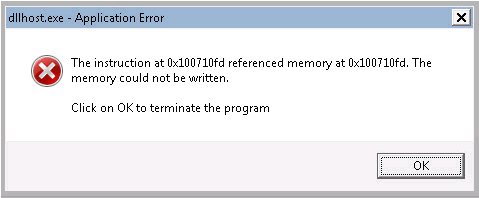What is dllhost.exe
Dllhost.exe is a Windows system file developed by Microsoft Corporation. The process is better known as COM Surrogate and it’s required for a stable work of web services. However, it is not uncommon to see dllhost.exe error message during computer startup or program startup. The fact of the matter is that the virus writers take advantage of vulnerable of file for their own devious ends. Malware files can crawl into your system using dllhost.exe name to avoid detection. In order to determine whether this legitimate file or virus, you should perform a scan by using your antivirus program.
Here you can see examples of dllhost.exe error messages:
- “Dllhost.exe Application Error.”
- “Dllhost.exe is not a valid Win32 application.”
- “Dllhost.exe has encountered a problem and needs to close. We are sorry for the inconvenience.”
- “Cannot find dllhost.exe.”
- “Dllhost.exe not found.”
- “Error starting program: dllhost.exe.”
- “Dllhost.exe is not running.”
- “Dllhost.exe failed.”
- “Faulting Application Path: dllhost.exe.”
Dllhost.exe Application Error can be caused by following issues:
- Damaged dllhost.exe registry entry;
- Malware infection has damaged the dllhost.exe file;
- Some program deleted the dllhost.exe file.

How to fix dllhost.exe error
The easiest way to fix the dllhost.exe error is to use a special computer optimizer Advanced System Repair. It will scan your computer for system errors and issues. Advanced System Repair has a wide range of solutions to most of the system problems, including dllhost.exe error. Install it and run the scan, then watch it fixing your system’s issues.
In order to fix dllhost.exe error manually, you should perform one of these troubleshooting methods:
Method 1: Fix the dllhost.exe error using System Restore
- Click the Start button on the left-bottom corner.
- Select the search box and type: System Restore. Then press ENTER.
- Choose a required restore point.
- Restore your computer.
Method 2: Fix the dllhost.exe error using Windows System File Checker
To run System File Checker:
- Click the Start button on left-bottom corner.
- Type “command” in the search box…
- Press CTRL+Shift simultaneously and then press ENTER.
- Click Yes in the opened dialog box
- Type “sfc /scannow” and press ENTER.
- System File Checker will start scanning for any system file errors
Method 3: Check and install updates for Windows
To check for Windows Updates (Windows XP, Vista, 7, 8, and 10):
- Click the Start button.
- In the search box, type “update” and press ENTER.
- The Windows Update dialog box will appear.
- Click the Install Updates button if updates are available.

